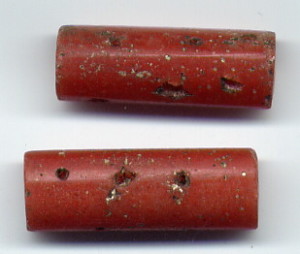There’s no mistaking coral beads once you’ve seen them. But, those made in Africa for trade over a hundred years ago looked rather different to the polished orange-red spheres we use today. African coral is characterized by distinctive natural inclusions, curious bore holes and an a rusty orange-red coloration.
Since coral was scarce, these beads were considered particularly valuable by the bead-loving Yoruba of Nigeria. Their worth was also measured against their popularity among the Yoruba by traders from the North, many of whom would bring vast quantities of beads in exchange for animal pelts, brass ornaments and oils. As the supply of coral beads dwindled, the resourceful Yoruba looked to producing their own imitations from recycled glass.
Glass Ateyun beads differ somewhat to the Recycled Glass Beads produced in Ghana in that they are not producing using glass molds, or the wet core technique. Instead, the fritt (glass powder) is moistened with water and rolled between the fingers to form a ball. A twig is gently pushed through the center of the bead to create the perforation hole, and they are then fired in an above ground kiln – usually made of clay. Once cool, they would be washed in a mixture of sand and water to age them. The vast majority of Ateyun beads were tubular or donut shaped, and were always red in color. Such was the likeness of some beads to coral, that even traders were duped into believing they were authentic. Unsurprisingly, they often bought quantities from the Yoruba to trade with other tribes in West Africa.
